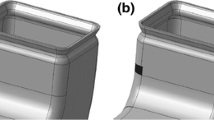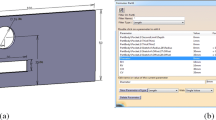Abstract
The motivation for this paper is to present an approach for rating the quality of the parameters in a computer-aided design model for use as optimization variables. Parametric Effectiveness is computed as the ratio of change in performance achieved by perturbing the parameters in the optimum way, to the change in performance that would be achieved by allowing the boundary of the model to move without the constraint on shape change enforced by the CAD parameterization. The approach is applied in this paper to optimization based on adjoint shape sensitivity analyses. The derivation of parametric effectiveness is presented for optimization both with and without the constraint of constant volume. In both cases, the movement of the boundary is normalized with respect to a small root mean squared movement of the boundary. The approach can be used to select an initial search direction in parameter space, or to select sets of model parameters which have the greatest ability to improve model performance. The approach is applied to a number of example 2D and 3D FEA and CFD problems.










Similar content being viewed by others
References
Chen S, Tortorelli DA (1997) Three-dimensional shape optimization with variational geometry. Struct Optim 13:81–94
Chen J, Freytag M, Shapiro V (2008) Shape sensitivity of constructively represented geometric models. Comput Aided Geom Des 25(7):470–488
Hardee E, Chang K-H, Tu J, Choi KK, Grindeanua I, Yu X (1999) A CAD-based design parameterization for shape optimization of elastic solids. Adv Eng Softw 30:185–199
Hardee E, Chang KH, Choi KK, Yu X, Grindeanu I (1996) A CAD-based design sensitivity analysis and optimization for structural shape design applications. In: 6th AIAA/USAF/NASA/ISSMO symposium on multidisciplinary analysis and optimization, Paper no. 96-3990, Hyatt Regency Bellevue, Bellevue, WA, September 4–6, pp 77–87
Yao TM, Choi KK (1989) 3-D shape optimal design and automatic finite element regridding. Int J Numer Methods Eng 28:369–384
Kripac J (1997) A mechanism for persistently naming topological entities in history-based parametric solid models. Comput Aided Des 29(2):113–122
Chang K-H, Choi KK, Tsai C-S, Chen C-J, Choi BS, Yu X (1995) Design sensitivity analysis and optimization tool (DSO) for shape design applications. Comput Syst Eng 6(2):151–175
Robinson TT, Armstrong CG, Chua HS, Othmer C, Grahs T (2009) Parametric effectiveness of CAD models and strategies for its improvement, Eighth World Congress on Structural and Multidisciplinary Optimization, Lisbon, Portugal
Alonso J, Martins J, Reuther J, Haimes R, Crawford C (2003) Aero-structural design using a parametric CAD-based model. In: Proceedings of the 16th AIAA computational fluid dynamics conference, AIAA 2003-3429. Orlando
Lindby T, Santos JLT (1997) 2-D and 3-D shape optimization using mesh velocities to integrate analytical sensitivities with associative CAD. Struct Multidiscip Optim 13(4):213–222
Kodiyalam S, Kumar V, Finnigan P (1992) A constructive solid geometry approach to three-dimensional structural shape optimization. AIAA J 30(5):1408–1415
Botkin ME (1992) Three-dimensional shape optimization using fully automatic mesh generation. AIAA J 30(7):1932–1934
Chang KH, Choi KK (1992) A geometry-based parameterization method for shape design of elastic solids. Mech Struct Mach 20(2):215–252
Zhang W-H, Beckers P, Fleury C (1995) A unified parametric design approach to structural shape optimization. Int J Numer Methods Eng 38:2283–2292
Giles MB, Pierce NA (2000) An introduction to the adjoint approach to design. Flow Turbul Combust 65:393–415
Choi KK, Kim NH (2005) Structural sensitivity analysis and optimization 1. Springer, New York
Suresh K (2007) Size, Material, and Shape Sensitivities of Boundary Value Problems: A Primer, Internal report no: ERSL-06-25 University of Wisconsin Madison
Othmer C (2008) A continuous adjoint formulation for the computation of topological and surface sensitivities of ducted flows. Int J Numer Methods Fluids 58:861–877
Jameson A (2003) Aerodynamic shape optimization using the adjoint method. VKI Lecture Series, vol. 2. Rhode St Gen`ese, Von Karman Institute, Belgium
Choi KK, Chang K-H (1994) A study of design velocity field computation for shape optimal design. Finite Elements Anal Des 15(4):317–341
Bertsekas DP (2003) Nonlinear programming, 2nd edn, Athena Scientific, Belmont, Massachusetts. ISBN 1-886529-00-0
Freidman JH, Bentley JL, Finkel RA (1977) An algorithm for finding best matches in logarithmic expected time. ACM Trans Math Softw (TOMS), v.3 n.3, p 209–226
Cervera E, Trevelyan J (2005) Evolutionary structural optimization based on boundary representation of NURBS. Part 1: 2D algorithms. Comput Struct 83:1902–1916
Armstrong CG, Robinson TT, Chua HS (2009) Sensitivity-based optimization of parameterized CAD geometries. In: Eighth world congress on structural and multidisciplinary optimization, Lisbon, Portugal
Gopalakrishnan SH, Suresh K (2008) Feature sensitivity: a generalization of topological sensitivity. Finite Elements Anal Des 44:696–704
Wang MY, Wang X, Guo D (2003) A level set method for structural topology optimization. Comput Methods Appl Mech Eng 192:227–246
Author information
Authors and Affiliations
Corresponding author
Rights and permissions
About this article
Cite this article
Robinson, T.T., Armstrong, C.G. & Chua, H.S. Determining the parametric effectiveness of a CAD model. Engineering with Computers 29, 111–126 (2013). https://doi.org/10.1007/s00366-011-0248-4
Received:
Accepted:
Published:
Issue Date:
DOI: https://doi.org/10.1007/s00366-011-0248-4




